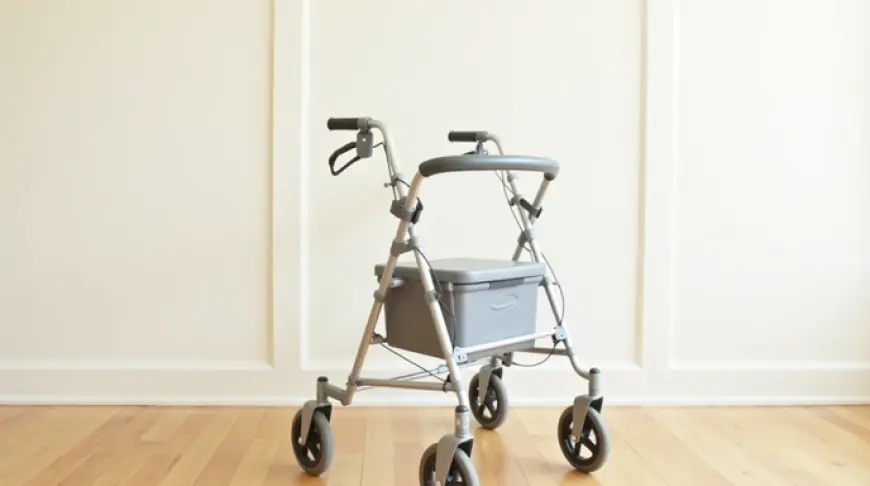How Portable Walking Helpers Are Revolutionizing Senior Mobility

As the global population ages, mobility challenges among seniors are becoming a critical area of focus for healthcare providers, designers, and families alike. Maintaining independence and quality of life is paramount for older adults, and mobility aids have long been a key factor in achieving this. However, traditional walking aids, while helpful, often come with limitations such as bulkiness, difficulty in transport, or lack of adaptability. Enter the new generation of portable walking helpers, compact, lightweight, and wheeled devices designed to meet the evolving needs of seniors.
These innovative tools are not just enhancing mobility, they’re revolutionizing it. Let’s explore how these Folding walkers with wheels are helping transform senior mobility, promoting independence, and improving overall well-being.
The Changing Landscape of Senior Mobility
For decades, seniors who needed assistance with walking primarily relied on basic walkers or canes. While these aids provide stability, they often restrict mobility due to their size and lack of portability. Many seniors found it challenging to take these aids with them outside the home or to store them conveniently when not in use. This often resulted in reduced outdoor activity, social isolation, and even increased risk of health complications linked to sedentary lifestyles.
Recognizing these barriers, engineers and healthcare innovators have focused on designing walking aids that can easily fold, collapse, or disassemble—making them truly portable. When combined with wheels, these devices provide smooth, effortless movement across different surfaces without the need for heavy lifting.
What Makes Portable Walking Helpers Different?
-
Compact and Lightweight Design:
Traditional walkers are often bulky and heavy, making them difficult to transport in cars or store at home. Portable walking helpers are designed with lightweight materials such as aluminum or carbon fiber and can fold down to a compact size. This enables seniors to carry them with minimal effort or tuck them away when not needed. -
Integrated Wheels for Ease of Movement:
Many portable walking aids feature wheels—ranging from two to four—that allow users to glide smoothly rather than lift and place the aid with every step. This reduces fatigue and the risk of falls, especially on flat surfaces such as sidewalks or indoors. -
Adjustability and Comfort:
These walking helpers come with adjustable height settings, ergonomic hand grips, and sometimes built-in seats or storage compartments, providing both comfort and convenience for users. -
Enhanced Safety Features:
Advanced models include hand brakes, reflective strips for nighttime visibility, and stability controls, addressing safety concerns for seniors who use them both indoors and outdoors.
Key Benefits Revolutionizing Senior Lives
1. Increased Independence
One of the most profound impacts of portable walking helpers is the boost to independence they provide. Seniors can leave the house with confidence, knowing their mobility aid won’t be a burden to carry or store. This means more trips to parks, shops, community centers, or visits to friends and family.
2. Encouraging Active Lifestyles
Mobility aids that are easy to take along encourage seniors to remain active. Regular walking has well-documented health benefits—improving cardiovascular health, strengthening muscles, enhancing balance, and boosting mood. Portable aids make it simpler for seniors to maintain these healthy habits.
3. Reducing Social Isolation
Social isolation is a serious issue among older adults, often exacerbated by mobility challenges. Portable walking helpers help seniors attend social events, visit friends, or join group activities, fostering a sense of community and emotional well-being.
4. Ease of Use and Adaptability
Thanks to their user-friendly designs, these aids require minimal effort to operate. Folding mechanisms are intuitive, and the lightweight build prevents strain or injury, making them suitable even for seniors with limited hand strength or dexterity.
5. Improved Safety and Confidence
With features like anti-slip grips, sturdy frames, and brake systems, portable walking aids help reduce the risk of falls—the leading cause of injury among seniors. Knowing they have reliable support boosts confidence during daily activities.
Real-World Impact: Stories from Seniors
Consider Mrs. Clara, a 78-year-old retiree who struggled with traditional walkers that were cumbersome and difficult to store in her small apartment. After switching to a portable, wheeled walking helper, Clara found she could visit her local farmer’s market without help for the first time in years. The lightweight frame and foldability meant she could easily transport it in her car and use it throughout the day with minimal fatigue.
Or Mr. James, an 82-year-old with arthritis, who appreciated the smooth rolling motion and adjustable hand grips of his new mobility aid. He reported less joint pain and more confidence in navigating uneven sidewalks, which previously deterred him from outdoor walks.
These examples highlight how portable walking helpers are not just devices—they are enablers of freedom and empowerment.
The Technology Behind the Revolution
Innovation in materials and design has played a major role in this mobility revolution. Here are some technological advancements that make portable walking helpers stand out:
-
Lightweight Metals and Composites: The use of aluminum alloys and carbon fiber has drastically reduced the weight of walking aids without compromising strength.
-
Ergonomic Engineering: Handles and grips are shaped to reduce strain, designed based on studies of human anatomy and user feedback.
-
Advanced Folding Mechanisms: Smooth, quick-folding systems allow for compact storage, often with one-handed operation.
-
Wheel Technology: Modern bearings and shock-absorbing wheels provide smooth rides even on uneven terrain.
-
Smart Features (Emerging Trend): Some next-gen models are incorporating sensors to monitor gait, alert caregivers in case of falls, or provide GPS tracking.
Choosing the Right Portable Walking Helper
With many options on the market, selecting the perfect aid depends on individual needs and preferences. Here are key factors seniors and caregivers should consider:
-
Weight and Size: Should be light enough to carry and compact enough to store.
-
Wheel Configuration: Four-wheeled models offer more stability and often include seats; two-wheeled models are more maneuverable but require some lifting.
-
Adjustability: Height and handle adjustments ensure ergonomic use.
-
Safety Features: Check for brakes, reflectors, and sturdy frames.
-
Additional Features: Storage pouches, foldability, and ease of use.
Consulting with a physical therapist or mobility specialist can also help tailor the choice to the user’s specific physical capabilities.
The Future of Senior Mobility
As technology continues to evolve, the future of portable walking aids looks promising. We can expect to see:
-
Integration with Smart Devices: Mobility aids connected to smartphones for health monitoring and emergency alerts.
-
Lighter, Stronger Materials: Advances in material science will produce even lighter frames.
-
Customizable Designs: 3D printing and modular components will allow for personalized walking aids tailored to unique body shapes and needs.
-
Enhanced Multi-Functionality: Devices that combine mobility with exercise support, seating, and storage.
Conclusion
Portable walking helpers are more than just mobility devices—they represent a shift toward empowering seniors to lead active, independent lives. By addressing the limitations of traditional aids through innovative design, portability, and safety, these tools are transforming the way older adults navigate their environments.
The benefits extend beyond physical support: improved confidence, social engagement, and emotional well-being all contribute to a higher quality of life. As this technology continues to advance, portable walking helpers will play an increasingly vital role in enhancing senior mobility—helping people move freely, comfortably, and safely wherever life takes them.
What's Your Reaction?
 Like
0
Like
0
 Dislike
0
Dislike
0
 Love
0
Love
0
 Funny
0
Funny
0
 Angry
0
Angry
0
 Sad
0
Sad
0
 Wow
0
Wow
0



















































